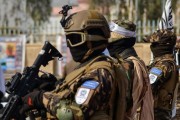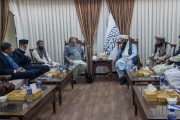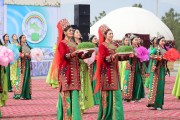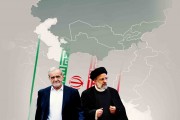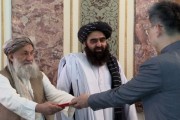Publish Date
Thursday 31 December 2020 - 09:45
recommended
0
The Perspective of Khaf-Herat Railway
In the heat of war and crisis in Afghanistan, a railway between Iran and Afghanistan was inaugurated for the first time by the presidents of the two countries. This railway connects Iran’s Khaf to Afghanistan’s Herat. Besides the fact that the extension of this railway would lead to a dramatic change in the economic relations of the two countries, it also depicts a great future for the region. This article will try to provide a futuristic analysis about this railway and examine its current and future efficiency.
By: Abdulshakoor Salangi
The Khaf-Herat railway in the context of Tehran-Kabul relations
Given to theoretical discussions, especially the Regional Security Complex Theory (RSCT), the relations and interactions of different countries are strongly influenced by the mutual security patterns. The mutual security pattern which determine how the countries interact, is subject to a variety of issues - such as border and territorial disputes, historical friendships and animosities, related population, ideological differences, etc. - and finally shows itself in the form of friendship or enmity between the countries that are located within a single regional security complex, especially the neighboring countries. In fact, the differences create a space for conflict, and similarities create a space for cooperation.
If we analyze the Iran-Afghanistan relations based on this assumption, we will see no negative issue in their mutual security pattern. There are no border or territorial disputes between the two countries. The only remarkable case is the presence of the Baluch people in both countries as the related population, on which not only there is no dispute, but also there is a kind of political alignment. Fortunately, the historical memory of the two countries lacks cases that evoke historical animosities.
On the contrary, there are many historical cases between Iran and Afghanistan that can inspire friendship and harmony to the current atmosphere of interaction between the two countries. In fact, there are deep and extensive cultural, linguistics, historical, and religious commonalities between Iran and Afghanistan that can contribute more and more to their convergence. Even the religious differences between Afghanistan and Iran have never acted as a divisive factor between the two countries.
The only issue that is sometimes mentioned is the issue of water. Even in this issue, there is no fundamental difference between Afghanistan and Iran and both of them act according to the bilateral agreement (on the Helmand River). But, no treaty or agreement has yet been concluded between the two countries about Harirud, an issue that in some cases leads to minor frictions.
According to the Regional Security Complex Theory, in addition to the patterns of friendship and enmity that will affect the atmosphere of interaction between two countries, the presence of external powers in a region also can act as an important factor. If we look at the history of the presence of the external powers in Afghanistan during the last few decades (the presence of the Soviet Union during the Cold War and the US since 2001), we can see that the atmosphere of interaction between Tehran and Kabul, quite apart from Iran’s relations with those powers, has continued in a normal and even friendly manner.
In general, it can be said that Despite the efforts of some circles [perhaps provoked by external factors] to disrupt the Tehran-Kabul relations, there has been no serious and specific issue between the two countries that can lead to securitization of their relation. In the light of this atmosphere, the opening of the first railway between Afghanistan and Iran called "Khaf-Herat railway" can promise a bright future because, as discussed before, the two countries are already experiencing a strongly correlated relationship despite the negative mutual security patterns that exist in the region.
The more mutual security patterns go towards contrast, the more cooperation, especially in the economic sector, will be weakened. Even if countries sign nominal economic agreements in such a situation, it will certainly lead to failure. A clear example of this claim can be seen in Afghanistan-Pakistan relations.
The role of Khaf-Herat railway in regional transit
Now we should ask that how this railway can strengthen the economic ties between the two countries and how it has a considerable capacity for the regional and intra-regional transit. To answer these questions, some points need to be considered:
First, what has severely affected the transit of the region and even the transit between Afghanistan and its neighbors is the lack of a railway network in the country. If we look at the history of land transportation, the invention of railway created a great revolution in the transit of goods and passengers. By transporting large volumes of goods and passengers at low cost and time, the railway helped to both rapid and greater exchange of goods as well as the development of economic ties. However, Afghanistan is one of the few countries that has never owned a proper railway network. This has not only acted as a negative factor in Afghanistan's domestic economic development, but has severely hampered the transportation of goods and passengers between the country and its neighbors. What is significant about the opening of the first railway between Afghanistan and Iran, is the incentive that it has created for the Afghan officials to extend the railway inside their own country.
Second, by connecting Afghanistan to Iran's railway network, more goods can be transported at a low cost and it can help to the expansion of economic ties between the two countries. Moreover, through this railway, Afghanistan can freely get access to the Iranian ports in the Persian Gulf, the Sea of Oman, and the Caspian Sea as well as the land ports in the western and northwestern regions of Iran. It can also help to the development of Chabahar port and turn it into a major loading and unloading hub between Afghanistan and other countries.
Third, this railway can be a prelude to an intra-regional railway network, with Afghanistan act as its crossroads. In the past and even now, Afghanistan, which is geographically located between the three regions of Central Asia, South Asia and West Asia, has played a separating role between the northern railway on one side and the southern and western railways on the other. With the extension of this railway inside Afghanistan and its connection to the Central Asian railways (which currently connects Termez in Uzbekistan to Mazar-e-Sharif and transfers goods from China to Afghanistan), the intra-regional connections can be facilitated. If developed inside Afghanistan, this railway not only connects Iran to the Central Asian countries and their railway networks, but also would pave Iran’s path towards China. If we want to formulate the perspective of this railway, it would be as follows: Iran + Afghanistan + Central Asia + China and vice versa.
Forth, Khaf and Herat currently have a good capacity to expand the transit of Afghan and Iranian goods through the rail network. Khaf is connected to Iran’s vast railway network, and, thus, can have a good capacity in this regard. Herat also has been one of the oldest economic hubs of Afghanistan, which plays an important role in unloading of imported goods. Moreover, the city of Herat has a high capacity in terms of geographical location and can become a center for loading and unloading of export and imported goods in the future. In the past, this city was called the gateway to India and it can be predicted that in the future this city can be the gateway of Iran to Central Asia and vice versa.
Other countries' views on the Khaf-Herat railway
The extension of the railway between Afghanistan and Iran, can make a big evolution in the regional as well as intra-regional transit in the future. The views of other countries in this regard can be analyzed from various dimensions:
The first dimension is related to the mutual security patterns existing between the beneficiary countries. In this regard, the countries can be divided into two categories. The first group of countries are those that have negative security ties with Afghanistan, which - thanks to God - includes just a single country: Pakistan. But, the second category includes a large number of countries such as Iran, India, the Central Asian countries, and China. So, if the creation of a regional and intra-regional transit line in the macro level considered as the ultimate goal - which was preceded by the opening of the Khaf-Herat railway-, then it can be said that the second category of countries see the railway as an opportunity. Meanwhile, the convergence of Afghanistan and Iran with the China’s OBOR plan, which the Central Asian countries are eagerly waiting for, can help achieve this goal.
But Pakistan, despite being considered as a passage (Kashgar-Gwadar) by China, has been losing ground and marginalized in the transit game with Afghanistan. In fact, Pakistan's poor performance in this regard has pushed the Central Asian countries as well as India towards the Iran-Afghanistan route; former to connect to southern hot water ports and latter to Central Asian markets and resources. Since the land routes can guarantee the security of China’s exports, Beijing also has a supportive view of the routes which connect the country to Eurasia by land.
In the macro Vision, although the Khaf-Herat railway appears to be a very small step, it can be considered as a spark that will create a big change in the future.
The second dimension is that in today's world, countries cannot achieve their development goals without having proper connection ways. In fact, we can talk about economic development only when the ways to the outside world are open. As the Chinese saying goes, “If you want to get rich, build a road first!"
As noted earlier, Afghanistan is geographically located between three regions. These three regions have no other choice but to cross Afghanistan to get connected to each other. In fact, this inevitable geographical condition has forced the regional countries to cross Afghanistan in order to reach beyond Afghanistan. That is why the extension of the new railway between Iran and Afghanistan can be the first step as well as an important model for others.
Third, what can make the extension of the new railway auspicious for Afghanistan's neighbors is its future political achievements. According to the convergence theories, one of the most effective approaches that can lead to the regional convergence is the increase of trade ties and transit connections between the regional states. From this perspective, the opening of the Khaf-Herat railway can be considered as a cornerstone of the regional convergence.
Conclusion
In conclusion, a few points can be made:
First, the good relation between Afghanistan and Iran not only has helped to the construction of the railway, but also will bring a good political and economic future for both countries.
Second, this railway can make the vision of a regional connection through land transport lines clearer and more practical.
Third, the increase of economic relations between the regional states (currently between Iran and Afghanistan) can lead to more convergence.
And the last point which related to the government and has a technical dimension is that the only serious obstacle in the way of connecting Afghanistan to its surrounding countries through railway, is lack of a proper railway network inside Afghanistan itself.
Therefore, the Afghan government, one of the slogans of which is to play the role of a regional crossroads, should pay special attention to this issue.
The Khaf-Herat railway in the context of Tehran-Kabul relations
Given to theoretical discussions, especially the Regional Security Complex Theory (RSCT), the relations and interactions of different countries are strongly influenced by the mutual security patterns. The mutual security pattern which determine how the countries interact, is subject to a variety of issues - such as border and territorial disputes, historical friendships and animosities, related population, ideological differences, etc. - and finally shows itself in the form of friendship or enmity between the countries that are located within a single regional security complex, especially the neighboring countries. In fact, the differences create a space for conflict, and similarities create a space for cooperation.
If we analyze the Iran-Afghanistan relations based on this assumption, we will see no negative issue in their mutual security pattern. There are no border or territorial disputes between the two countries. The only remarkable case is the presence of the Baluch people in both countries as the related population, on which not only there is no dispute, but also there is a kind of political alignment. Fortunately, the historical memory of the two countries lacks cases that evoke historical animosities.
On the contrary, there are many historical cases between Iran and Afghanistan that can inspire friendship and harmony to the current atmosphere of interaction between the two countries. In fact, there are deep and extensive cultural, linguistics, historical, and religious commonalities between Iran and Afghanistan that can contribute more and more to their convergence. Even the religious differences between Afghanistan and Iran have never acted as a divisive factor between the two countries.
The only issue that is sometimes mentioned is the issue of water. Even in this issue, there is no fundamental difference between Afghanistan and Iran and both of them act according to the bilateral agreement (on the Helmand River). But, no treaty or agreement has yet been concluded between the two countries about Harirud, an issue that in some cases leads to minor frictions.
According to the Regional Security Complex Theory, in addition to the patterns of friendship and enmity that will affect the atmosphere of interaction between two countries, the presence of external powers in a region also can act as an important factor. If we look at the history of the presence of the external powers in Afghanistan during the last few decades (the presence of the Soviet Union during the Cold War and the US since 2001), we can see that the atmosphere of interaction between Tehran and Kabul, quite apart from Iran’s relations with those powers, has continued in a normal and even friendly manner.
In general, it can be said that Despite the efforts of some circles [perhaps provoked by external factors] to disrupt the Tehran-Kabul relations, there has been no serious and specific issue between the two countries that can lead to securitization of their relation. In the light of this atmosphere, the opening of the first railway between Afghanistan and Iran called "Khaf-Herat railway" can promise a bright future because, as discussed before, the two countries are already experiencing a strongly correlated relationship despite the negative mutual security patterns that exist in the region.
The more mutual security patterns go towards contrast, the more cooperation, especially in the economic sector, will be weakened. Even if countries sign nominal economic agreements in such a situation, it will certainly lead to failure. A clear example of this claim can be seen in Afghanistan-Pakistan relations.
The role of Khaf-Herat railway in regional transit
Now we should ask that how this railway can strengthen the economic ties between the two countries and how it has a considerable capacity for the regional and intra-regional transit. To answer these questions, some points need to be considered:
First, what has severely affected the transit of the region and even the transit between Afghanistan and its neighbors is the lack of a railway network in the country. If we look at the history of land transportation, the invention of railway created a great revolution in the transit of goods and passengers. By transporting large volumes of goods and passengers at low cost and time, the railway helped to both rapid and greater exchange of goods as well as the development of economic ties. However, Afghanistan is one of the few countries that has never owned a proper railway network. This has not only acted as a negative factor in Afghanistan's domestic economic development, but has severely hampered the transportation of goods and passengers between the country and its neighbors. What is significant about the opening of the first railway between Afghanistan and Iran, is the incentive that it has created for the Afghan officials to extend the railway inside their own country.
Second, by connecting Afghanistan to Iran's railway network, more goods can be transported at a low cost and it can help to the expansion of economic ties between the two countries. Moreover, through this railway, Afghanistan can freely get access to the Iranian ports in the Persian Gulf, the Sea of Oman, and the Caspian Sea as well as the land ports in the western and northwestern regions of Iran. It can also help to the development of Chabahar port and turn it into a major loading and unloading hub between Afghanistan and other countries.
Third, this railway can be a prelude to an intra-regional railway network, with Afghanistan act as its crossroads. In the past and even now, Afghanistan, which is geographically located between the three regions of Central Asia, South Asia and West Asia, has played a separating role between the northern railway on one side and the southern and western railways on the other. With the extension of this railway inside Afghanistan and its connection to the Central Asian railways (which currently connects Termez in Uzbekistan to Mazar-e-Sharif and transfers goods from China to Afghanistan), the intra-regional connections can be facilitated. If developed inside Afghanistan, this railway not only connects Iran to the Central Asian countries and their railway networks, but also would pave Iran’s path towards China. If we want to formulate the perspective of this railway, it would be as follows: Iran + Afghanistan + Central Asia + China and vice versa.
Forth, Khaf and Herat currently have a good capacity to expand the transit of Afghan and Iranian goods through the rail network. Khaf is connected to Iran’s vast railway network, and, thus, can have a good capacity in this regard. Herat also has been one of the oldest economic hubs of Afghanistan, which plays an important role in unloading of imported goods. Moreover, the city of Herat has a high capacity in terms of geographical location and can become a center for loading and unloading of export and imported goods in the future. In the past, this city was called the gateway to India and it can be predicted that in the future this city can be the gateway of Iran to Central Asia and vice versa.
Other countries' views on the Khaf-Herat railway
The extension of the railway between Afghanistan and Iran, can make a big evolution in the regional as well as intra-regional transit in the future. The views of other countries in this regard can be analyzed from various dimensions:
The first dimension is related to the mutual security patterns existing between the beneficiary countries. In this regard, the countries can be divided into two categories. The first group of countries are those that have negative security ties with Afghanistan, which - thanks to God - includes just a single country: Pakistan. But, the second category includes a large number of countries such as Iran, India, the Central Asian countries, and China. So, if the creation of a regional and intra-regional transit line in the macro level considered as the ultimate goal - which was preceded by the opening of the Khaf-Herat railway-, then it can be said that the second category of countries see the railway as an opportunity. Meanwhile, the convergence of Afghanistan and Iran with the China’s OBOR plan, which the Central Asian countries are eagerly waiting for, can help achieve this goal.
But Pakistan, despite being considered as a passage (Kashgar-Gwadar) by China, has been losing ground and marginalized in the transit game with Afghanistan. In fact, Pakistan's poor performance in this regard has pushed the Central Asian countries as well as India towards the Iran-Afghanistan route; former to connect to southern hot water ports and latter to Central Asian markets and resources. Since the land routes can guarantee the security of China’s exports, Beijing also has a supportive view of the routes which connect the country to Eurasia by land.
In the macro Vision, although the Khaf-Herat railway appears to be a very small step, it can be considered as a spark that will create a big change in the future.
The second dimension is that in today's world, countries cannot achieve their development goals without having proper connection ways. In fact, we can talk about economic development only when the ways to the outside world are open. As the Chinese saying goes, “If you want to get rich, build a road first!"
As noted earlier, Afghanistan is geographically located between three regions. These three regions have no other choice but to cross Afghanistan to get connected to each other. In fact, this inevitable geographical condition has forced the regional countries to cross Afghanistan in order to reach beyond Afghanistan. That is why the extension of the new railway between Iran and Afghanistan can be the first step as well as an important model for others.
Third, what can make the extension of the new railway auspicious for Afghanistan's neighbors is its future political achievements. According to the convergence theories, one of the most effective approaches that can lead to the regional convergence is the increase of trade ties and transit connections between the regional states. From this perspective, the opening of the Khaf-Herat railway can be considered as a cornerstone of the regional convergence.
Conclusion
In conclusion, a few points can be made:
First, the good relation between Afghanistan and Iran not only has helped to the construction of the railway, but also will bring a good political and economic future for both countries.
Second, this railway can make the vision of a regional connection through land transport lines clearer and more practical.
Third, the increase of economic relations between the regional states (currently between Iran and Afghanistan) can lead to more convergence.
And the last point which related to the government and has a technical dimension is that the only serious obstacle in the way of connecting Afghanistan to its surrounding countries through railway, is lack of a proper railway network inside Afghanistan itself.
Therefore, the Afghan government, one of the slogans of which is to play the role of a regional crossroads, should pay special attention to this issue.
Abdulshakoor Salangi, is an Afghan researcher based in Kabul
News code:2506






